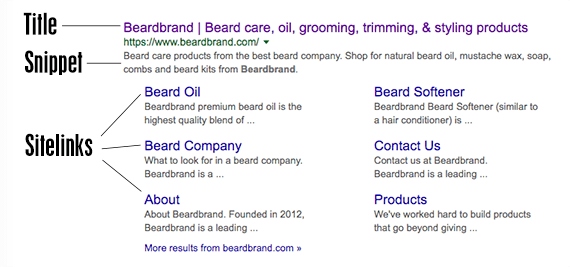You’ve done the technical search engine optimization steps. You’ve worked hard to create useful, even authoritative content that answers common questions — keyword queries — for your industry. You’ve earned your spot near the top of the results page. So why not try to boost clicks and conversions too?
Search engine optimization is meant to communicate the value of your site’s content to both the search engine and, ultimately, to the person who will click on your result.
There is a lot you can do to make your business look good on a search engine results page, including influencing the title, snippet or description, and even sitelinks.
Search Result Anatomy
Let’s start with a reminder of how an individual search result can look on Google. This one is from online retailer Beardbrand.

A typical SERP result will include a title, snippet, and optional sitelinks.
The title is probably the first thing your potential site visitor will see. It serves as a description for the page or site. You have a significant amount of influence over how this title appears in most Google search results.
Next, you have the snippet or description. This can come from a few different sources and may vary based on the specific keyword query the user entered into Google. But you still have a fair amount of influence over how this appears.
Finally, there are sitelinks awarded to the most authoritative results on the SERP. Google uses its algorithm to determine when and what is shown here, but you can still encourage sitelinks with good navigation and structure.
Although Google changes how it presents a given result from time to time, it has almost always included the three elements described above. In fact, you can watch Matt Cutts talk about result anatomy in detail is this video from nearly a decade ago. The title, snippet, and sitelinks are included.
Page Titles
Found in the descriptive “<title>” tag on your website, your page title can, and often does, directly influence the search result title that users see on Google.
“The title tag is typically the most weighted on-page element, so it’s important that you optimize it correctly,” said SEO practitioner Greg Gifford in a lecture from SEMrush Academy’s SEO Fundamentals Course.
“Skip the old school tactic of ‘keyword phrase bar keyword phrase two bar keyword phrase three.’ Remember, this is going to be your blue in the SERP – you need to write something interesting that will entice people to click through to your site.’
You may even want to think about your page title like a keyword-rich advertising headline, built to entice a Google search user to click through to your website.
There are at least two approaches to writing click-inducing page titles. Gifford encourages a prose title akin to what you might find on an article page. Others have suggested a segmented title that includes important keywords separated by a vertical bar, hyphen, or comma.

The title of the Beardbrand home page includes the company name and a segment with prose — “Beard care, oil, grooming, trimming, & styling products.”
Beardbrand may be blending these approaches, using a bar to separate the brand name from a phrase that describes what the store sells.
Beardbrand | Beard care, oil, grooming, trimming, & styling products
For your ecommerce business, test a few title formats. Your goal is to accurately describe the page in a way that will encourage users to click.
As you develop your site pages, note that an H1 tag could also be your SERP title. Google can and does change the title displayed on a SERP when it believes a change helps the user.
As Matt Cutts put it in a 2014 video, Google is “looking for a concise description of the page that’s also relevant to the query….If your existing HTML title fits [Google’s title criteria] then often the default will be to just use your title. Now if your current title, as best as we can tell, doesn’t match that…we might dig a little bit deeper.”
In at least some cases, deeper may mean your page’s H1 tag. So take the same level of care creating it as you would the title tag.
Meta Descriptions
The snippet or description section of an organic Google result gives a user more information about your page. It is the extra details, if you will, that can help to drive site traffic.
Google will draw snippet copy from page content or, perhaps most often, from your page’s meta description tag.
In the ecommerce context, your meta descriptions need to be relatively short, active (meaning they use strong verbs), descriptive of the page or product, and keyword inclusive to help with ranking and recognition.
You have a significant amount of influence over what Google will show on the SERP. So use it to encourage the click.
“It doesn’t really matter how often you show up [on a SERP], it matters how often you get clicked on,” again according to Matt Cutts.
Sitelinks
If your page ranks well for a particular keyword search, Google may reward your result with sitelinks, linking directly to additional pages on your site. In the Beardbrand example, these included links to beard oil and products.
According to Google, “sitelinks, are meant to help users navigate your site. [Google’s] systems analyze the link structure of your site to find shortcuts that will save users time and allow them to quickly find the information they’re looking for.”
While you cannot directly influence when and how Google assigns sitelinks to your organic search result, you can make it relatively easier for Google.
- Have a clear internal site hierarchy.
- Include alt text in each link.
- Use descriptive anchor text.